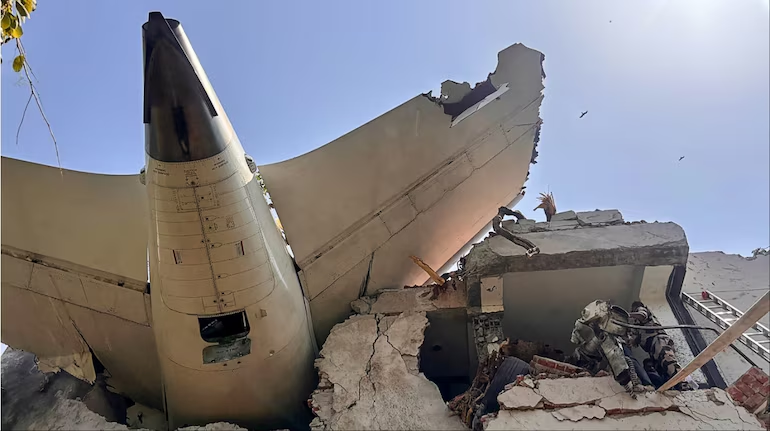A preliminary investigation into last month’s fatal crash of an Air India Boeing 787 Dreamliner has revealed confusion in the cockpit moments before the aircraft lost power and plunged into a densely populated neighborhood in Ahmedabad, killing 260 people. The crash, deemed the deadliest aviation disaster globally in over a decade, is now under intense scrutiny as experts question the function and handling of critical engine fuel cutoff switches.
According to a report released Saturday by the Aircraft Accident Investigation Bureau (AAIB) of India, both of the aircraft’s engine fuel cutoff switches flipped almost simultaneously just after takeoff on June 12, leading to the engines being starved of fuel. This triggered a rapid loss of thrust and altitude, ending in a catastrophic fireball crash into a nearby building.
Pilots in Disagreement During Final Moments
The cockpit voice recorder captured a disturbing exchange. One pilot reportedly asked, “Why did you cut off the fuel?” to which the other replied that he hadn’t. The AAIB report did not specify which of the two pilots made the remarks, nor who issued the panicked “Mayday, Mayday, Mayday” call seconds before the crash.
Captain Sumeet Sabharwal, 56, a senior pilot and instructor with over 15,600 hours of flight experience, was commanding the flight. His co-pilot, Clive Kunder, 32, had logged 3,403 hours in the cockpit. Both were among the deceased.
Closed-circuit footage from the airport also showed the deployment of the ram air turbine — a device that activates when main engine power is lost — within seconds of takeoff, further confirming a complete engine failure.
Mystery Surrounds Fuel Switch Movement
The report does not explain how the engine fuel switches could have moved from “run” to “cutoff” in flight. Aviation experts are puzzled.
“It’s very unlikely a pilot could flip both switches accidentally,” said Anthony Brickhouse, a U.S.-based aviation safety expert. “If they were manually moved, the question is — why?”
U.S. aviation analyst John Nance observed that the switches flipped one second apart — roughly the time it would take for a human to flip each one manually. “There is no reason a pilot would shut off both engines during climb-out,” he said.
Strangely, the switches were later found in the “run” position at the crash site, and there was evidence of both engines attempting to relight just before the crash. However, by then the aircraft was too low to recover.
Memorials and Grief
On Saturday, mourners gathered at a Mumbai church for a memorial service honoring the lost crew. Emotional scenes unfolded as friends and family paid tribute. When approached by reporters, the father of co-pilot Kunder declined to comment, stating only, “I am not from the airline.”
Wider Implications for Tata and Air India
The crash poses a significant challenge for Tata Group, which acquired the loss-making national carrier from the Indian government in 2022 with plans for a high-profile turnaround. Since the takeover, Tata has been striving to modernize Air India’s aging fleet and restore public confidence.
In a brief statement, Air India acknowledged the AAIB report and confirmed ongoing cooperation with investigators but declined to comment further.
No Immediate Action for Boeing or GE Engines
The U.S. National Transportation Safety Board (NTSB), which is collaborating with the investigation, expressed appreciation to Indian officials and noted that the report recommended no immediate action for operators of Boeing 787 aircraft or GE-manufactured engines.
The U.S. Federal Aviation Administration (FAA) emphasized its commitment to following the facts and addressing any safety risks identified. Boeing and GE Aerospace both confirmed their support for the investigation, though GE did not provide specific comments.
Crash Dynamics
The aircraft reportedly climbed to 650 feet after liftoff before rapidly losing altitude. The AAIB report said the plane struck trees, an incinerator chimney, and then a building — which resulted in a devastating fire. The black boxes — the cockpit voice recorder and flight data recorder — were recovered and analyzed in India.
All aircraft directives and service bulletins had been complied with, the AAIB noted, suggesting that the aircraft was technically airworthy at the time of departure.
Regulatory Spotlight on Indian Aviation
The Air India crash is not the only safety concern. The European Union Aviation Safety Agency (EASA) recently announced plans to probe Air India Express, a subsidiary, following a Reuters report alleging non-compliance with engine replacement directives and falsification of maintenance records for Airbus A320 aircraft.
India’s civil aviation strategy hinges on becoming a global aviation hub — a vision modeled after Dubai — and this series of incidents could slow that trajectory.
“We care for the welfare and well-being of pilots, so let’s not jump to any conclusions at this stage,” Civil Aviation Minister Ram Mohan Naidu told local channels, urging restraint until the final report is published.
Final Report Pending
The AAIB is expected to release a full, final report within a year. Until then, questions around cockpit procedures, mechanical integrity, and safety oversight remain open — and troubling.

